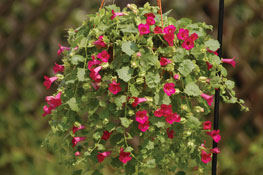11/26/2014
Go Long or Short With Lofos
Delilah Onofrey

Looking at adding flowering vines or something unique to your annuals program? Consider Lofos Lophospermums from Suntory Flowers. Growers have two choices—Lofos in Wine Red and White and the newer Lofos Compact in Compact Rose and Compact White. Beautiful trumpet flowers cascade from elegant foliage that resembles grape leaves.
The classic Lofos varieties will reach a length of 7 ft., creating a stunning display. Plants are vigorous and self-cleaning; no deadheading is required. Lofos blooms from the top to the end of the vines. These varieties are especially nice for grower/retailers, who don’t need to sleeve and transport the plants. They also look gorgeous trained to a trellis in large containers.
Lofos Compact varieties were bred to be grower friendly and were very well-received by growers who produced them for the first time last season. These plants will reach a length of about 2 ft. and produce more flowers on top of the plant. Flowers are smaller but in greater number. These varieties present nicely in baskets and in gallons. Use in combinations to bring cascading elegance to large patio planters.
General culture
Rooted cuttings should be potted up as soon as possible into 4-in. (10-cm) and 6-in. (15-cm) pots. One pinch after the initial planting will help to develop breaks in the plants. After two weeks, the crop will grow quickly and start to produce vigorous trailing shoots. These can be pinched to enable the plant to bush out and develop a good breaking habit. But once plants are trailing, you won’t want to pinch, as the flower buds are on the vine.
Crop timing
6-in. pots—6 weeks with one liner
1-gal. pots—8 to 9 weeks with one liner and two pinches
10-in. pots/baskets—10 to 12 weeks with three liners and two to three pinches
Watering
After potting the liners, give plants a light watering. The crop is best kept on the dry side to aid root development. Keep plants slightly dry, but avoid wilting.
Feeding
Use a well-drained peat/perlite mix and maintain soil pH between 6.0 and 6.5. Feed with a complete water-soluble fertilizer at 200 ppm.
Lighting
Keep light levels high to moderate, between 5,000 and 8,000 footcandles. Although flowering isn’t related to day length, higher light levels will produce more flowers. Supplemental lighting is recommended for early spring finishing.
Temperature
Begin at 60 to 65F (15 to 18C) for the first two weeks to help roots develop. Then keep day temperatures between 65 to 75F (18 to 23C) and night temperatures between 55 to 60F (12 to 15C).
Growth regulators
Pinching the leading shoots helps control the growth. Lofos is responsive to Florel. Keep light levels high to reduce stretching. If the plant gets too long, just wrap the tendrils in on the plant. Do not trim the vines because that’s where the new flowers will bloom.
Pests & diseases
In general, Lofos isn’t prone to insect and disease problems. Monitor for aphids, fungus gnats, whiteflies, leaf miners, red spider mites, shore flies, slugs, snails and Western flower thrips. Diseases to prevent include Botrytis, Powdery Mildew, Phytophthora and Pythium. A broad-spectrum fungicide drench is recommended after planting.
Download the Grower’s Guide App!
Interested in more production advice for all your Suntory Flowers varieties? Download the free Grower’s Guide app for iPads in the iTunes app store or from a link at
www.suntorycollection.com. It’s on the YESS page—Your Easy Suntory Solution.
GT
Delilah Onofrey supports Suntory Flowers marketing in North America. She can be reached at (440) 522-1447 or donofrey@gmail.com.